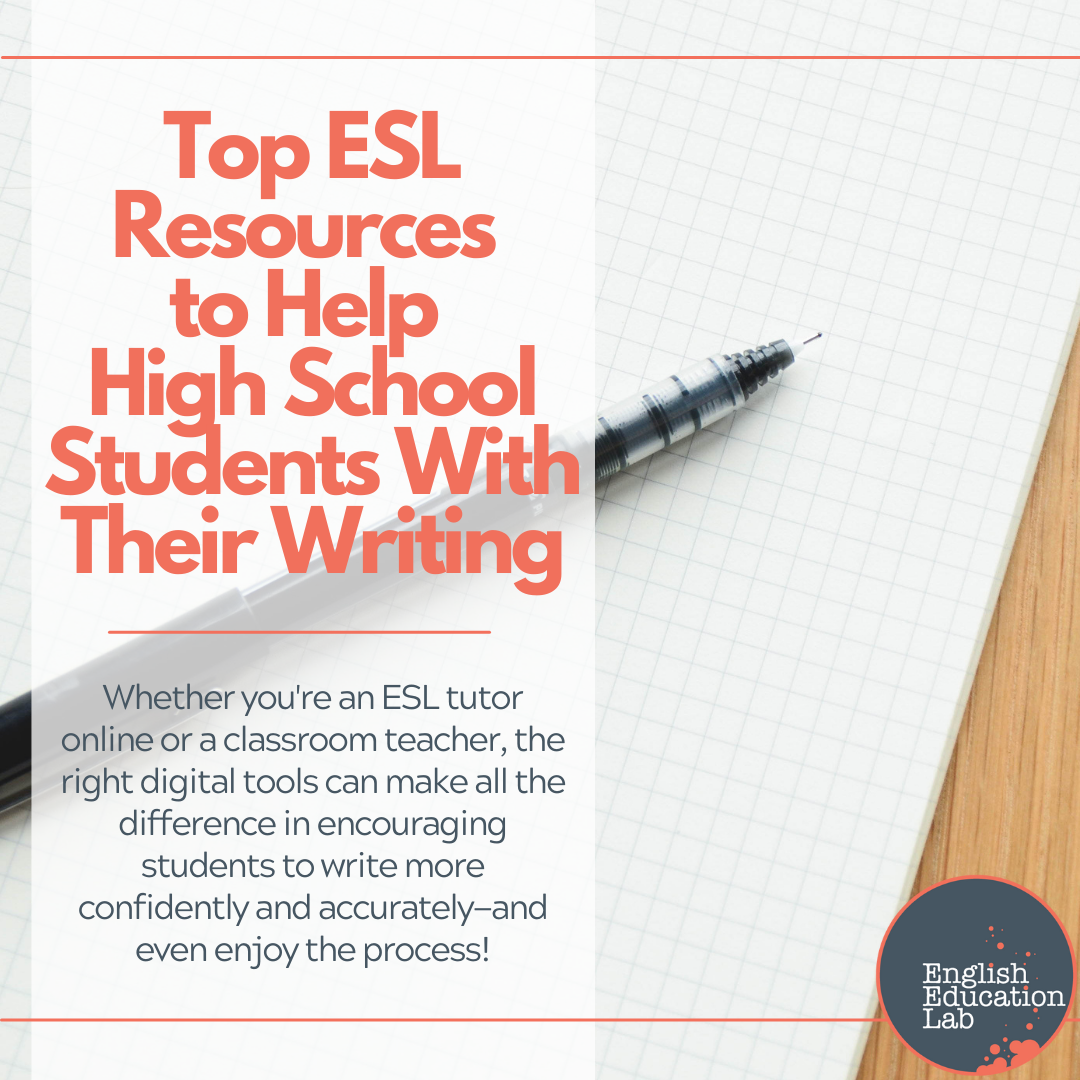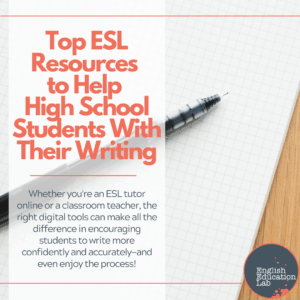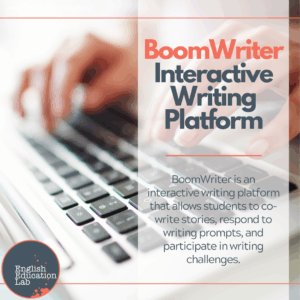
Top ESL resources to help high school students practice writing

Helping high school ESL students strengthen their writing skills doesn’t have to be a challenge. Whether you’re an ESL tutor online or a classroom teacher, the right digital tools can make all the difference in encouraging students to write more confidently and accurately—and even enjoy the process! In this post, we’ll explore some of the best ESL resources for teachers, specifically platforms that support structured writing practice, instant feedback, and personalized growth.
1. English Education Lab
English Education Lab is a one-stop hub for both ESL teachers and students, offering unique, conversation-driven ESL resources and courses. Designed by an experienced ESL tutor online with over 26 years of experience, the platform specializes in creating lesson plans and digital materials that blend speaking, writing, vocabulary-building, and critical thinking.
When it comes to writing, English Education Lab provides printable and digital worksheets featuring writing prompts, TED Talk-based lessons, and debate resources that challenge students to express their opinions in structured, persuasive ways. These are ideal for students who have moved past basic grammar drills and are now developing academic writing, argumentation, and reflective expression.
Why it’s useful:
The lessons encourage authentic, purposeful writing. Because the topics are engaging and often tied to real-world issues (e.g., mental health, technology, or cultural identity), students become more invested in what they write. This increases motivation, improves fluency, and builds writing confidence.
How to use it:
Use the downloadable worksheets for homework, writing portfolios, or timed in-class assignments. For example, after discussing a TED Talk in class, students can be assigned follow-up writing tasks to summarize the speaker’s argument or reflect on the topic personally. The lessons also work well in flipped classrooms and blended learning settings.
2. Write & Improve by Cambridge English
Write & Improve is a free online writing tool developed by Cambridge English that allows learners to write and receive instant, detailed feedback. Students input their writing based on a prompt, submit it, and receive an estimated CEFR level, grammar corrections, and suggestions for improvement.
This is an ideal resource for high school students preparing for exams like IELTS or Cambridge English qualifications, but it’s also excellent for everyday writing practice. The platform tracks progress over time, which is especially valuable for teachers assessing student development.
Why it’s useful:
The instant feedback function is what sets Write & Improve apart. Many ESL students hesitate to write because they fear making mistakes. This tool removes that fear by offering low-pressure, private feedback that they can use to self-correct. For teachers, it’s like having an assistant that provides initial corrections so class time can be used for deeper analysis.
How to use it:
Create student accounts and assign weekly writing prompts. Use the “Workbooks” feature to group tasks and monitor submissions. Students can revise their submissions and resubmit for updated feedback, encouraging editing skills. Pair the tool with lessons from English Education Lab to give structure and purpose to writing practice.

3. Grammarly for Education
Grammarly is widely known among professionals and college students, but its education version is ideal for high school ESL learners. Beyond grammar and spell check, Grammarly provides feedback on tone, clarity, vocabulary, and conciseness.
For ESL students who are transitioning into more academic forms of writing, this tool acts as a personal writing coach. It helps students see their most common errors and gives explanations that help them understand why something is incorrect, fostering long-term improvement.
Why it’s useful:
Unlike static grammar exercises, Grammarly adapts to each student’s writing. Over time, students begin to internalize patterns of good writing. It also supports vocabulary expansion and the use of more formal or appropriate expressions, which is key at the high school level.
How to use it:
Teachers can encourage students to write their essays in Google Docs or Word with the Grammarly extension enabled. For classroom activities, students can first draft by hand or in a text editor and then review their work through Grammarly for edits. Teachers can use before-and-after comparisons to highlight progress and teach grammar points in context.
4. BoomWriter
BoomWriter is an interactive writing platform that allows students to co-write stories, respond to writing prompts, and participate in writing challenges. The collaborative nature of the platform makes writing feel like a fun, shared experience rather than a solitary task.
For ESL classrooms, this means more opportunities to practice narrative writing, creative storytelling, and peer review—all essential skills for high school students. The competitive elements (like voting on the best chapter or prompt responses) keep students motivated and invested.
Why it’s useful:
BoomWriter adds fun and community to writing practice. It’s especially good for classrooms where engagement is a challenge. Writing is no longer just a graded task but a creative, social process. It also builds confidence in using English expressively.

How to use it:
Start a class story project where each student contributes a chapter or paragraph. Assign persuasive writing contests with themes like “Should mobile phones be banned in school?” Let students vote and discuss each other’s work, creating a full-circle literacy experience. Teachers can guide grammar and structure lessons based on common errors seen in submissions.
Bonus tips for ESL tutors online:
If you’re working as an ESL tutor online, combining these platforms can help simulate a full classroom experience. Here’s how:
-Begin your session with a writing prompt or a video-based discussion (e.g., using English Education Lab’s TED Talk lessons).
-Ask students to write a short opinion paragraph or summary.
-Have them paste their response into Write & Improve or Grammarly for instant feedback.
-Review the feedback together during the session to reinforce learning.
-Use BoomWriter as a collaborative homework task to keep them writing between sessions.
By using tools like these, your online lessons become more interactive, engaging, and outcome-oriented. Plus, you’re giving students tools they can continue to use independently—which is the ultimate goal.
Final Thoughts
If you’re searching for the best English courses online or practical ESL resources for teachers, these platforms offer powerful, easy-to-use tools that make writing less intimidating and more rewarding. High school students, in particular, need ongoing exposure to writing tasks that are purposeful, personalized, and feedback-driven.

By combining structured resources like those found at www.englisheducationlab.net with advanced digital tools like Write & Improve, Grammarly, and BoomWriter, you can transform your writing lessons and equip your students with skills that go far beyond the classroom.
So whether you’re in a physical classroom or working as an ESL tutor online, take advantage of these smart tools and see your students’ writing skills flourish!
Subscribe to my YouTube Channel!
Struggling to get your ESL students talking? We’ve got you covered! Download our FREE ESL teacher’s survival kit now and transform your ESL lessons into dynamic, student-led conversations!
Further Reading
Breaking barriers: Using ESL teaching materials to discuss women’s rights
Transform your ESL lessons with TED Talks: Powerful teaching resources for ESL teachers
Middle and high school ESL teaching resources inspired by current U.S. political events
Innovative ESL resources for teachers: Unlocking the power of social media conversations
The question of time: How long does it take to learn English?


Transform your ESL lessons with TED Talks: Powerful teaching resources for ESL teachers


